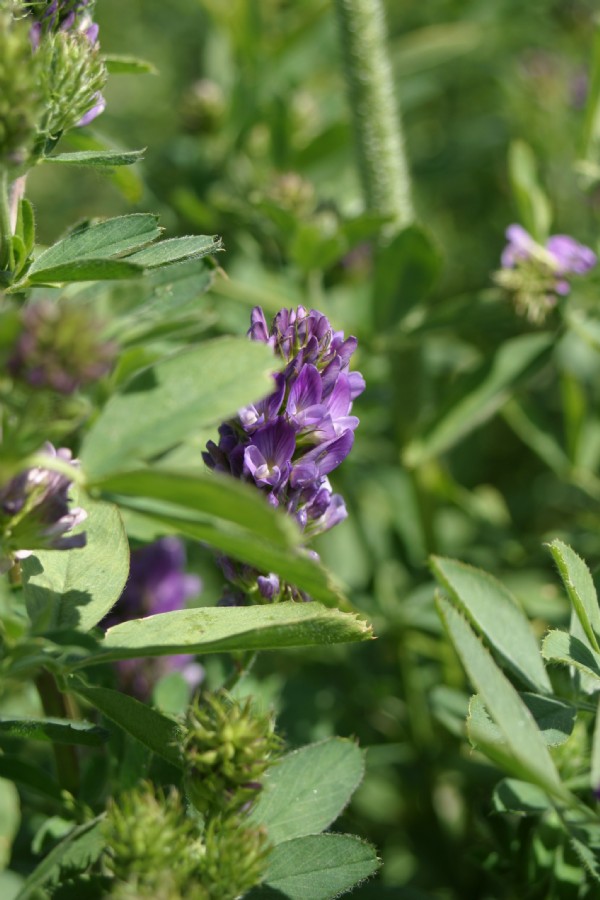

Cut three times a year, lucerne produces a protein-rich 14t DM per hectare without nitrogen fertiliser and on dry land.
No one can really understand why so little lucerne is grown in the UK, when worldwide there is 13 million hectares cropped for forage. There are however a small number of UK farms now retrying this capable legume.
Why Lucerne?
Most forage legumes are best grown in mixtures with grasses as this increases yield. Lucerne (or Alfalfa) is different because it provides a high annual yield of around 14t DM per hectare on its own and without nitrogen fertiliser. It is also drought resistant. Not just a bit either. Once established, the root structure is vast and deep. Ploughing in a lucerne crop is an education in itself. There was once a soil pit dug on a farm in Berkshire going down twenty feet. The roots of an established lucerne crop could be clearly traced all the way down. So this is a legume which can provide reliable high yields irrespective of drought.
Should More Be Grown?
At 20% protein, lucerne is an attractive feed. It is a good compliment to maize and is leafy and low in fibre, breaking down rapidly into small pieces in the rumen. It quickly passes out of the rumen, allowing a greater intake of forage than many other species. So, lucerne has significant benefits but few people grow it, believing that it is difficult. The crop is slow to establish and does require careful management, but if agronomic guidelines are followed there is nothing complicated about it. It is estimated that one million acres of land are suitable in the UK. However, best estimates amount to no more than 15,000 acres of lucerne currently grown in the UK.
What is Lucerne for?
Lucerne should be sown as a four or five year temporary ley. It is not a grazing plant as it causes bloat and is much better suited to the production of silage for dairy cows, cattle or sheep. For specialist use it may be made into hay for the equine market where it is also known as alfalfa.
Where to Grow It Successfully
Lucerne is suited to naturally alkaline and free-draining soils. It is severely restricted on soils with pH below 6.2. Liming will not be enough to correct naturally acidic soils. Chalk and limestone soils are most suitable and waterlogged soils should never be sown to lucerne.
How to Establish Lucerne
Lucerne is slower to establish than ryegrass. For this reason many farmers undersow lucerne to a spring cereal crop. Priority should be given to the lucerne by reducing the sowing rate of the cereal by one third and cutting as arable silage or wholecrop. Others prefer to sow in the summer following an early-harvested cereal such as winter barley. The middle of August is the latest date for sowing, provided a good seedbed can be made and there is sufficient moisture available. Whether undersown or direct drilled (without cover), the seed should be sown into warm soil so that rapid germination occurs otherwise weeds may become a problem. Herbicides exist but are limited and with increasing restrictions on their use it is good practice to obtain a clean seedbed prior to sowing.
The seed of lucerne is of a similar size to clover and needs to be kept to a maximum depth of 15mm otherwise a patchy, thin crop will result. The use of a roller prior to and after sowing will get the seed into good contact with the soil giving faster germination. Hard or frequent grazing should be avoided especially during its first year as the crop will not tolerate it. Although lucerne requires no nitrogen once established conventional farmers might find it be beneficial to apply 25kgN per hectare when sown in the autumn as this will promote quicker plant development. Phosphate and potash requirements are higher than for grass and need to be met to maintain yields. An ADAS Index 2 is required for P and K.
Making into Silage
Following a direct spring sowing a light cut may be taken in mid August. Otherwise from a summer sowing or an undersowing there will be little to cut. This crop ought to be left until the following spring when it should be cut for the first time in late May. Lucerne should be cut at the bud stage as this provides the ideal compromise between yield and quality. Two or three further cuts follow at six week intervals. Ideally, the lucerne should be allowed to grow for a few weeks into the winter as this allows the plant to build up root reserves.
The principles of making lucerne silage are the same as for other crops such as grass or maize. The high protein and low sugar content can make it difficult to ensile. It is for this reason that growing companion grasses such as meadow fescue or timothy with lucerne can be helpful since this ensures that there is adequate soluble sugar present to give satisfactory anaerobic fermentation. After cutting, the crop needs wilting so that it contains less than 70% moisture when made into baled silage. It is important to use an approved additive when conserving lucerne and to exclude air to allow the correct fermentation to proceed. A well fermented lucerne/grass silage has a dry matter of 30%, a crude protein of 20%, a D-value of 60 and an ME of 9.7MJ.
Date Posted: 30th March 2017



